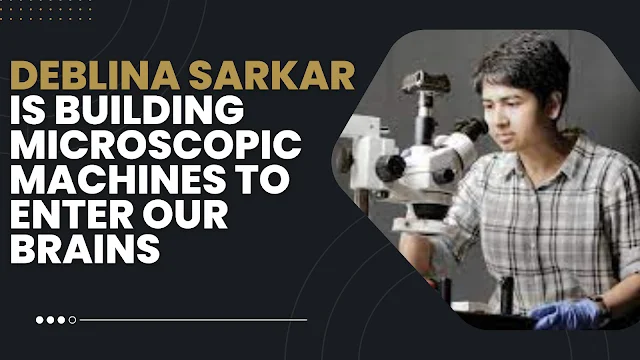Deblina Sarkar is creating tiny machines that can go into our brains.
She dreams of using these very small machines to help heal brain illnesses.
Deblina Sarkar creates tiny machines with huge dreams. These machines are so small that they can fit inside living cells. And her dreams are so big that they might one day help keep your brain healthy.
Sarkar is a nanotechnologist and an assistant professor at MIT. She creates extremely small electronic devices, some even smaller than a speck of dust, with the hope that they will one day be able to enter the brain. She also enjoys watching Kung Fu movies and putting her own spin on Bharata Natyam, a classical Indian dance style. Every now and then, she goes hiking with her graduate students, and they once went all the way to Yellowstone. Sarkar believes it’s important to build strong relationships with her students. But I have to say, I’m always busy with my research because there’s an important problem I need to solve.
The problem Sarkar is focused on is Alzheimer’s disease, Parkinson’s disease, and other neurological conditions that affect millions of people globally. Her solution involves using tiny machines to identify and potentially reverse these disorders.
“She has always been intrigued by using electronics in biological systems,” says Samir Mitragotri, a collaborator and bioengineering researcher from Harvard University who has known Sarkar for approximately ten years and served on her thesis committee. He believes Sarkar’s tools have the potential to revolutionize how biology is conducted by connecting different fields and merging their capabilities.
An emphasis on nanoelectronics.
Born in Kolkata, India, Sarkar finds inspiration in both of her parents. Her mother’s courage, demonstrated by challenging social norms and advocating for education, instilled in her a boldness as a researcher. Meanwhile, her father ignited her interest in engineering.
At 15, Sarkar’s father had to set aside his dream of becoming an engineer to support his family after his father, an Indian freedom fighter, was injured and unable to work. Despite this, he found time to pursue his passion for inventing gadgets to improve daily life, like a handcrafted washing machine and sturdy vehicles for transporting goods to their home.
“That made me super excited about science and technology,” says Sarkar.. “Especially engineering.“
After getting a bachelor’s degree in electrical engineering from the Indian Institute of Technology Dhanbad, Sarkar went to California to learn about nanoelectronics at the University of California, Santa Barbara. There, she explored new methods for making tiny devices that could use less power in computers and other common electronics.
During her time in graduate school, Sarkar created a remarkable device called a transistor. This device was able to cut down on the amount of power wasted as heat by a whopping 90 percent when compared to many of the silicon transistors that are commonly used today. This achievement was so significant that UC Santa Barbara honored Sarkar with the Lancaster Award for her Ph.D. dissertation, recognizing the major contribution it made to advancing mathematics, physical sciences, and engineering.
When technology and the body come together
During her journey,
Sarkar developed a keen interest in the brain, which she describes as “the lowest energy computer.” Her research as a postdoctoral researcher at MIT involved imaging
amyloid-beta plaques, leading her to merge her two passions. She continued her work at MIT as an assistant professor, founding the
Nano-Cybernetic Biotrek group. In this group, she focuses on creating nanodevices that can interact with living cells and developing “
neuromorphic” computing devices inspired by the human brain and nervous system.
The
Nano-Cybernetic Biotrek group’s most groundbreaking invention so far is the
Cell Rover, a flat antenna designed to monitor processes inside cells. In a study published in 2022, Sarkar and her team successfully inserted a
Cell Rover, about the size of a tardigrade, into a mature frog egg cell using magnetic fields. They demonstrated that when exposed to a magnetic field generated by alternating current, molecules within the nanodevice vibrated at frequencies safe for living cells. By employing a wire coil receiver, the researchers detected how these vibrations influenced the nanodevice’s magnetic field, indicating its ability to communicate with the external environment.
Cell Rovers could potentially be equipped with films capable of detecting specific proteins or other biomolecules.
Sarkar dreams of using the device to detect misfolded proteins in the brain, which could be early indicators of Alzheimer’s disease. Currently, memory loss is the only symptom of Alzheimer’s that we can observe in a living person, but by the time it’s noticed, the damage is already done and can’t be reversed, Sarkar explains. Cell Rovers could also work with nanodevices that collect energy from and stimulate cells electrically, paving the way for new kinds of brain electrodes and tiny pacemakers within cells. Alternatively, groups of remotely controlled devices could replace invasive surgeries by identifying small tumors in the brain and perhaps even eliminating them.
Mitragotri highlights that Sarkar is essentially creating a new field of science that combines nanoelectronics and biology. He believes there are numerous opportunities for the future in this intersection of disciplines.
One day, Sarkar dreams of placing tiny devices between human neurons to enhance the processing speed of our brains. She acknowledges the incredible capabilities of our brains but believes that we have the potential to improve even further.






